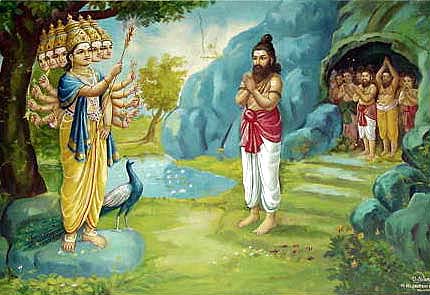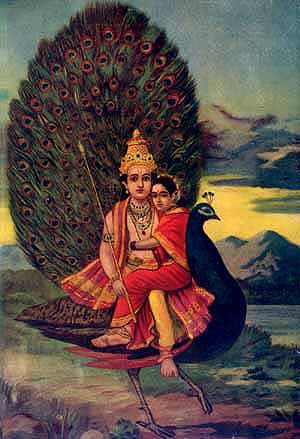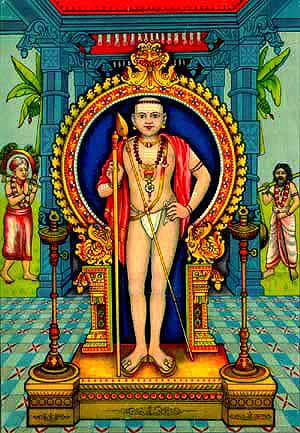
|
|||||||||||
|
| |||||||||||
Skanda Cult in South IndiaFrom The Cultural Heritage of India, Vol. IV (Calcutta:
Ramakrishna Mission, 1956) pp. 309-313.
|
 |
| Lord Muruga frees Nakeerar and 999 fellow captives upon hearing him sing the Tirumurugarrupadai at Tirupparankundram. |
The foregoing description does not constitute the whole picture of the cult. Old Tamil works or the Sangam age picture Him as the victorious ‘Red-god' who bears the ‘gem-like' peacock flag and rides a peacock or an elephant. He is the commander of the hosts of heaven. The Tirumurugarrup-padai praises Him as ‘child of the daughter of Himavat, borne down to the earths by Agni and nursed by the six krttika-devis in the grassy pool on the Himalayas. Here the identification of Murugan with Skanda of the Aryans is complete. Nakkirar, the poet who sang the Tirumurugarruppadai, tells us how Kurava girls on the hill-side planted a cock banner[3] smeared with ghee and mustard, offered to the God garlands of red oleander and green leaves, burnt incense, made oblations of balls of cooked rice mixed with goat's blood, and danced to the tune of sweet melodies. Elsewhere, the poet tells us that Brahmanas, who strictly followed the six duties[4] and the codes of Dharma and tended the sacred fires, worshipped Skanda with flowers chanting holy mantras. The mystic is not forgotten in the poem, and we are told that in his heart Guha (Skanda) was enshrined.
The poet sees significance in each one of the God's six faces. One removes the darkness and ignorance of the world and bathes it in light; the second grants boons to His devotees; the third protects the yajna; the fourth discourses upon the knowledge of the Self; the fifth destroys evil demons; and the sixth glances lovingly at the face of Valli, His bride from the hills. Nakkirar mentions Tiruchendur, Tiruparankunram, Tiruvavinankudi (Palani), Tiru-veragam (identified with Swamimalai), and Palamutirsolai (identified with Alagarkoil) as the places of Murugan's principal shrines; but generally all hilly tracts are sacred to Him. Murugan, the divine child of perennial beauty, is alike the God of the pre-Aryan Vedda and Kurava, the Brahmana, and the mystic.
In the Tirumurugarruppadai and in the earlier poems that sing of Murugan's glory, there are clear references to Murugan vanquishing the demons. This theme has been expatiated upon at great length in the later Sanskrit and Tamil poems. As in Kalidasa's Kumarasambhava, the Tamil prabandhas considered His victory over the asuras and liberation of the devas from captivity as the prime purpose of His manifestation. The demoniac hosts were led by the three brothers, Surapadma, Simhamukha, and Taraka, who represented respectively the three basic factors of avidya or nescience, ahankara (self-centred ego governed by likes and dislikes), krodha (wrath), and moha (illusion). Skanda with His spear, representing illumination, destroyed the forces of avidhya.[5]
 |
| Valli Murukan |
Skanda Subrahmanya-Siva
There is an unbroken continuity in the evolution of the Skanda cult in the Tamil land, as evidenced by the presence of the statues of this God dating from the seventh century. The Siva temples of the early Cola period (ninth to tenth century) had a number of sub-shrines, ranging from seven to thirty-five in some cases, and Subrahmanya was installed in one of them. At Kannanur, there is a svayampradhana[6] temple of Bala-Subrahmanya, solely dedicated to this god, which was constructed in the reign of one Rajakesari, identified with Aditya Cola I (AD 871-907). It is perhaps the earliest dated karrali or temple built with stone from the base to the finial. At each of the four comers of the roof over the sanctum of this temple is an elephant.[7] In this temple, and in those of later periods dedicated to Skanda, the niches on the walls of the sanctum have idols that are usually installed in the niches of Siva temples. In the niche on the southern wall is Dakshinamurti. The mutilated idol of Bala-Subrahmanya in the Kannanur temple is represented with one of the hands in cin mudra (the gesture of communicating divine wisdom), another holding a rosary, and a third bearing His weapon, the sakti (vel).
At Tiruvengaivasal, there is a rare sculpture of Subrahmanya (eleventh century) in bas-relief, in the veerasana pose, represented as holding a rosary and the sakti. There are sculptures of Subrahmanya depicting Him as holding a jar of nectar (amrta kalasa) in addition to the rosary. The rosary, jar, and cin mudra are associated with Dakshinamurti — Siva in His aspect as All-wisdom and the great guru. They are also associated with several forms of Devi, such as Sarada and Bala-Tripurasundari, who are the wisdom aspects of Devi. Subrahmanya is also jnana-pandita and guru.[8]
By about the sixth century, the Skanda cult had shed its association with the earliest indigenous forms of worship practised by the hill-tribes, the Veddas and the Kuravas, and had been incorporated in the Saiva Agamas. The Kumara Tantra was looked upon as a branch of the Saiva Tantras, and Skanda was invested with some of the attributes usually associated with Siva, for instance, Mahayogin, the great Teacher, the great Healer,[9] and the Lord of the Bhutas. Siva, though sharing His form with Uma, is still the ideal of asceticism.[10] Subrahmanya, the Lord of Valli and Devasena, is likewise the great Ascetic.[11] The five elements are the different bodies of Siva. The sparks of effulgence that emanated from Siva's eye manifested themselves first in akasa (ether), then in vayu (air), then in agni (fire), then in ap (water), and finally in prthvi (earth), before they assumed the form of Kumara Skanda.
Skanda Images
The earliest plastic representations that we know of this synthesis of Skanda with Siva and Uma were expressed in the Somaskanda sculptures of the Pallava period from the seventh-eighth century. Somaskanda bronzes are among the finest examples of Cola art. In them are represented on the same pedestal Siva and Uma with baby Skanda in between. The Somaskanda images mark an advance over the Uma-Mahesvara bronzes and sculptures of the Pallava and Cola periods, which had their counterpart, in North India in the Hara-Parvati images of the Gupta and Pala periods. Siva is Sat (Existence); Uma is Cit (Knowledge); and Skanda is Ananda (Bliss). The three together constitute Brahman who is Existence-Knowledge-Bliss Absolute. The mantra of Skanda consists of six letters: the first two are Sakti bijas, the second two Kumara bijas, and the last two Siva bijas. Skanda who is the form of Ananda is an aspect of the Supreme.[12] Ananda is the resultant of Sat and Cit. In the form of Sanmukha are both Siva and Sakti. Five of His faces are those of Siva,[13] and the sixth is that of Uma.[14] The weapons and mudras in eleven out of His twelve hands are the emblems of the eleven Rudras, while the sakti that He holds in the twelfth hand represents Devi.
This synthesis is again emphasized in the following esoteric interpretation of Skanda-tattva. His vehicle, the peacock, represents the Vedas; and He is the Pranava (the syllable Om), the essence of the Vedas. His weapon, the sakti, is Brahmavidya,[15] jnana-sakti (power of knowledge). Valli, His consort to the right, is iccha-sakti (power of will), and Devasena, His consort, to the left, is kriya-sakti (power of action). The Vedas being the sabda or sound form of the universe, the peacock symbolizes the universe or the evolutionary trend of Maya. The cock on Skanda's banner stands for nivrtti or the path of wisdom leading to the knowledge of the Self. Sri Sankara, in his Bhujangaprayata-stotra, praises Skanda as Mahavedabhava (the essence of the Vedas) and Mahavakyagudha (the Truth enshrined in the great Vedantic maxims)
Skanda Cult in South India Popularity of Skanda in South India
The Skanda legends in the Ramayana, the Mahabharata, and the Puranas are popular in the South, but the most authoritative scripture of the cult is the story of His manifestation and lilas as narrated in the Sankara Samhita of the Skanda Purana, which was rendered into Tamil in the epic Kanda Puranam in about the tenth century. Hymns in praise of Skanda are numerous in Tamil. Arunagiri (fifteenth century) and Kumara Guru Para (seventeenth century) are the foremost among the hymnists who have sung of Skanda's glory. For sublimity of thought and depth of mystic feelings, Arunagiri's hymns have few rivals in the entire range of devotional literature. His songs transport the devotee from the adoration of Sakala Murugan to the contemplation of Niskala Paramananda-veli (the formless expanse of infinite Bliss), which is the svarupa laksana or inherent attribute of Skanda.
The procession of devotees—men, women, and children of every rank and station in life, trudging their way to Murugan's shrines, invoking His holy names and bearing kavadis[16] or ornamented bamboo poles, to which are hung small pots containing milk, sugar, honey, flower, and fruits — is a common but inspiring spectacle in the South. Murugan destroys the ills that flesh is heir to. He destroys likewise the ills of samsara, the cycle of birth and death. Many a siddha in the Tamil land has invoked Him as Guru Guha (the divine Teacher who dwells in the cave of the heart).
END NOTES
[1] A weird dance marked by the expression of frenzy.
[2] A dance in a ring.
[3] The finds in the old urn-burial sites at Adiccanallur include iron tridents (vel), banner bases, and representations of fowls in bronze. See K, A. N. Sastri, Aryanisation of South India.
[4] Satkarma, viz. reciting the Vedas and leaching them, performing sacrifices and helping others id perform them, and giving alms and receiving them.
[5] A sculpture at Aihole, representing Skanda destroying Taraka, and another at Tiruchendur, depicting His combat with Surapadma, exhibit considerable vitality and power combined with divine grace.
[6] A temple in the sanctum of which Subrahmanya is installed.
[7] The elephant is one of the vehicles of this God. Sometimes He is sculptured as riding a goat, which represents the blending of the Agni and Skanda cults. Skanda is Vahnigarbha or Agnibhu (born of Agni). Agni is also identified with Rudra.
[8] In Swamimalai, Skanda is worshipped as Sivaguru or Svaminatha. There is a Tamil tradition that Skanda came to be called Svaminatha, the ‘great Lord', because He expounded to Siva the significance of the Pranava. It will be of interest to compare this image of Svaminatha, represented in Swamimalai as an elderly sage with a beard and two arms, with the peculiar iconographic Javanese concept of Bhattaraguru, sometimes called Sivaguru, identified by some scholars as Agastya. Could it be that this concept combines the Murugan and Agastya cults which are two distinct Tamil contributions to Javanese art and religion? Such a synthesis is not unknown in Java, e.g. the Siva-Buddha and Siva-Surya combinations. The Javanese Bhadaraguru is represented either as two-armed or as four-armed, and the emblems and mudras of cither form are suggestive of sonic forms of Skanda in the Tamil country, e.g. the rosary, water jar, and trident. This suggestion was made by Śrī K. R. Srinivasan of the Archaeological Survey of India, who recently visited Java; it deserves further investigation.
[9] ‘Gurave, samalokanam, bhisaje bhavaroganam' —Dakshinamurti Stotra
[10] ‘Kantasammisradeho'pi . . . yah purastad yatmam.'
[11] He is worshipped as such in the famous shrines at Palani and Swamimalai.
[12] ‘Anando Brahmeti vyajanat'—Taittiriya Upanisad, III 6
[13] The five faces are Sadyojata, Aghora, Vamadeva, Tatpurusa, and Isana.
[14] Skanda Purana, Sankara Samhita, Sambhava Kanda
[15] ‘Veda eve mayurassyat pranavassanmukhastatha; Brahmavidyapi saktissyat moksastaddarsanat smritah' – Skanda Purana
[16] The kavadi pole has an esoteric significance: to the initiate in Kundalini-yoga, it stands for the spinal column, on one end of which is the pericarp of the lotus called kulasahtisra-kamala, and on the other that of another lotus called akulasahasra-kamala.
